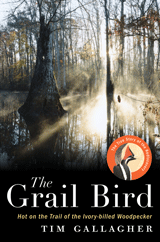TIM GALLAGHER 2005. The grail bird.
14 maart 2009 · Gert Ottens · 8503 × bekeken
DB 28 (1) 2006
Hot on the trail of the Ivory-billed Woodpecker. Published by Houghton Mifflin, 222 Berkeley Street, Boston, USA; website www.hmco.com. 272 p. ISBN 0-618-45693-7. USD 25.00.

The recent rediscovery of the supposedly extinct Ivorybilled
Woodpecker Campephilus principalis in White
River Reserve, Arkansas, USA (cf, eg, Dutch Birding 27:
250-253, North American Birds 59: 198-206, 2005;
www.birds.cornell.edu/ivory) is meticulously described
in the second half of this book, and the author himself
was an important link in the chain leading to the rediscovery.
After a report in spring 2004 by kayaker Gene
Sparling, the author (working at Cornell Laboratory of
Ornithology, Ithaca, New York, USA) was forwarded the
news by Mary Scott (see below) and subsequently visited
the area together with his close friend Bobby
Harrison and the observer. Gallagher, who had been
investigating the fate of this species for some time, confirmed
the presence of at least one Ivory-billed Woodpecker.
After this, a full expedition was set up by
Cornell Laboratory, eventually resulting in a few
seconds of blurry video footage and presumed sound
recordings of the species: (just) enough to publish the
official rediscovery. At the time of writing this review,
the ultimate evidence (a good photograph or video) had
yet to be produced, so undoubtedly there will be several
other books about the rediscovery after this ultimate
evidence has been collected.
The first half of the book deals mainly with the history
of this species and especially with the many previous
claimed sightings since the last 'official' observations
in the USA in the late 1930s and, finally, 1944.
The previous last known site was the Singer Tract
(owned by the Singer Corporation) in northern
Louisiana. Over the objections of the National Audubon
Society, the old growth forests in the Singer Tract were
logged in the early 1940s using German prisoners of
war as forced labourers. President Roosevelt specifically
refused to act to protect the last known Ivorybills.
Gallagher spoke, for instance, with Nancy Tanner,
widow of Jim Tanner, who studied the species in the
1930s; they saw the species during their honeymoon.
Another interview is with Fielding Lewis, an ex-boxer
who took two photographs of a male Ivorybill in
Louisiana in 1971 (one of which was published) but
only encountered disbelief and accusations of fraud and
who was never interviewed directly before. The author
also describes Mary Scott, who devoted part of her life
to the searching of Ivorybills and claimed three sightings;
her website detailing Ivorybill claims paid an
important role in the eventual chain of events leading to
the official rediscovery (see www.birdingamerica.com).
Gallagher also refound the sound recording made by
John Dennis in Big Thicket, Texas, in 1966 (Dennis, an
ornithologist and popular author of bird books, knew
the species and took the last scientifically accepted
photographs of the species in Cuba in 1948). The result
of Gallagher's investigations is a compelling feeling that
several reports of the species between 1944 and 2004 -
and their observers - should probably have deserved a
fairer treatment.
After 1944, the species had become a sort of Holy
Grail, and this made serious ornithologists in the
USA for decades think twice when they were informed
about a claimed sighting. Reputations could easily be
damaged, something that happened to the respected
George Lowery, who at an ornithological congress
dared to show Fielding Lewis's photographs and seemingly
never recovered from the shock of being stigmatised
as just another 'believer'. So, imagine the courage
of John Fitzpatrick, the director of the Cornell
Laboratory and Tim Gallagher's boss, when he not only
believed the non-ornithologist Gallagher but also started
to send expeditions into the Arkansas swamp forests.
How could this seemingly conspicuous species elude
the many birders and ornithologists in the USA during
all those decades? Gallagher tries to explain this as follows.
Birders are not interested in going deep into the
impenetrable swamp forests, as that would never produce
any other species than the ones you will see at the
border of the forests. Moreover, the species always was
very shy, and may even have become more shy in these
decades. And then there is the before-mentioned but
understandable disbelief by ornithologists when ordinary
people claimed to have seen the woodpecker,
especially because of the resemblance to the common
Pileated Woodpecker Dryocopus pileatus.
The second half of the book is about the actual rediscovery
in Arkansas, for which several people can be
credited. Despite Gallagher's detailed narrative, from
recent discussions on the internet it seems still unclear
who of the birders, semi-birders and nonbirders
in the USA should deserve the major credits.
Anyway, again it is demonstrated that most rare birds
are seen by non- or semi-birders as their number strongly
exceeds the number of birders.
Interwoven in the book's two main story lines (the
history of sightings and the rediscovery) is quite a bit of
'human interest' which may be needed for selling the
book to a wider audience but which also distracts from
the main story. However, from a birder's perspective,
Gallagher did a great job in demonstrating how important
casual sightings of birds can be for ornithology, and
that strenuous pursuit will eventually be rewarded, and
by putting his research together in this most readable
and fascinating book. JOHN VAN DER WOUDE & JAN VAN
DER LAAN

